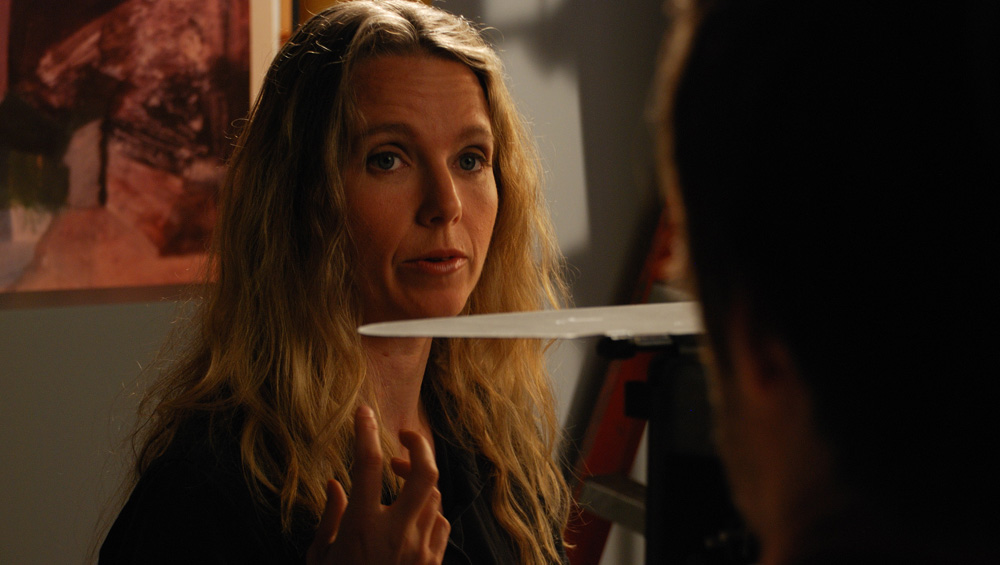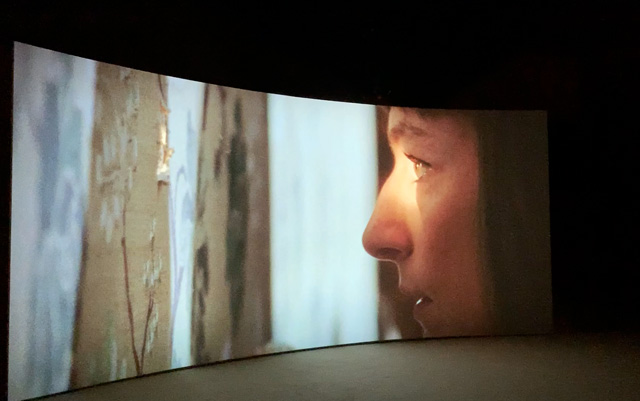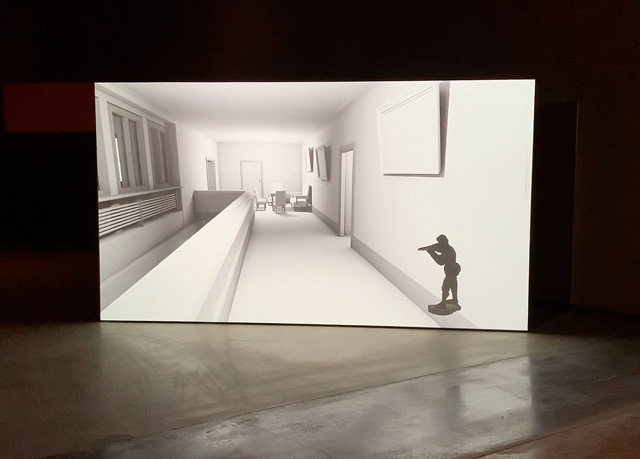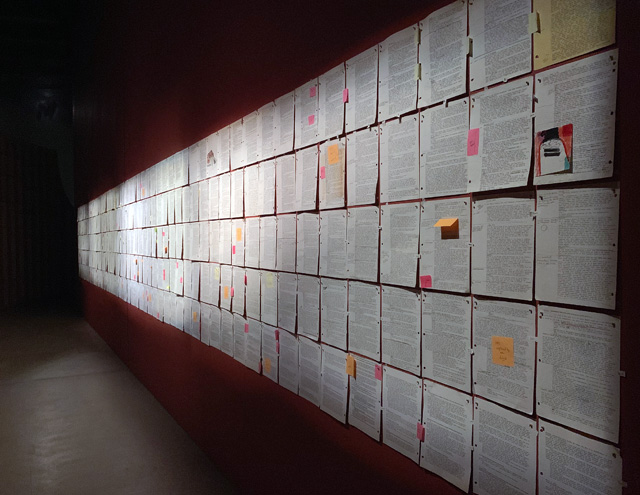
Daria Martin © Courtesy Maureen Paley, London.
by NICOLA HOMER
Daria Martin, who was born in California in 1973, is an important artist on the London art scene. She has exhibited at Tate Britain and at the contemporary art festival Manifesta in Italy, and now has her largest commission in a public gallery to date, at the Barbican’s Curve Gallery in London. A professor at Oxford University’s Ruskin School of Art, she won the 2018 Film London Jarman Award, a £10,000 prize for artists using moving images. (The award was inspired by the work of the visionary British artist and film-maker Derek Jarman, who was known for his avant-garde films and work as a set designer.)
It is with great anticipation that I wait to meet Martin at a London cafe on a winter’s day. Then I receive a message on my phone, saying: “I’m just around the corner.” The moment of suspense as to what might come next is characteristic of Martin’s film Tonight the World, on show at the Barbican’s Curve Gallery. Martin walks through the door with the grace of an early colour film star. After politely offering me a cup of tea, she tells me how it feels to win the award: “I feel honoured and happy. It’s a nice reward for hard work.”

Daria Martin: Tonight the World, installation view, The Curve, Barbican Centre, London, 2019. Photo: Martin Kennedy.
Martin has been making films for almost 20 years: one of her best-known artworks is Soft Materials, featuring a delicate choreography between naked dancers and machines. The film was produced in 2004, in collaboration with an artificial intelligence lab at the University of Zurich that makes robots programmed to learn from their bodies and their environments. At the time, it was on the cutting-edge of robotic technology, says Martin: “It has got a lot of circulation in the last few years, where there has been so much interest in AI and post-humanism and our relationship with technology.”
As part of a UK-wide touring exhibition of the Jarman Award, Martin exhibited her feature film A Hunger Artist (2017), which is derived from Franz Kafka’s 1922 short story of the same name. Set in an imaginary Victorian fairground, the film presents a theatrical take on the allegory of an artist. Pictured in a cage, the isolated figure of the artist seems hungry for attention. Yet the character fails to win the appreciation of the audience. While Martin found that Kafka was very funny, she says the more tragic side of the story came out in the rendering in real images and real bodies. So, what inspired this award-winning work?
“It’s based very closely, in fact, on Kafka’s short story, which was in a collection of short stories all about artists of different kinds,” she says. “Although, oddly, the way it describes the plight of the artist is the last thing I had in mind when making it. I was attracted to it partly because I’d been working with some hospital outpatients who were being treated for anorexia, and it describes a similar psychology, you could say, of somebody who exerts a lot of control over his body and makes a spectacle of himself.
“But I also enjoyed the black comedy of the story because it seems to describe ways that all of us these days are hyperconscious about making images of ourselves through social media, through self-promotion and the whole neo-liberal machine. I thought it’s not only people with eating disorders who suffer from looking at themselves too much as objects, but ourselves as a wider culture, and the story is very articulate in talking about those issues in kind of a funny way.”

Daria Martin. Tonight the World, 2019. Anamorphic 16mm film transferred to HD, 13.5 min. © Daria Martin, courtesy Maureen Paley, London.
Skinder Hundal, chief executive of Nottingham’s New Art Exchange and a judge of the 2018 Film London Jarman Award, says of Martin’s film: “It also has this kind of ironic satire within it, which creates another enhanced layer as you experience the kind of film that she creates.” Speaking on behalf of the jury panel members in a phone call after my interview, he explains that the quality and the innovation of the work, and how the artist demonstrates a repertoire within the genre of film-making, were deciding factors in the judging process. “For me,” says Hundal, “Daria Martin’s film and her style has a distinct signature that asks questions of who we are and where we are, using profound imaginations and styles of film-making, that make her stand out as a deserving winner of 2018.”
While Martin is celebrated now as a film-maker, her roots lie in the creative practice of painting. The artist learned to paint with her grandmother, who participated in a painting group near San Francisco called Sight and Insight, run by the American artist Ann O’Hanlon. The poet and painter Etel Adnan was also part of this group. After studying humanities at Yale University, Martin completed a master’s in fine art at the University of California, Los Angeles. Although she started art school as a painter, she soon moved into film-making. She explains why she decided to make that transition: “I’m interested in human psychology and narrative and theatre in a sense. And the way I was painting, which was quite formal, quite abstract, didn’t feel up to the task of tackling those things. Working in film was a shortcut into a much more layered world of possibility. And the films began more static and more painterly, and gradually they opened up to be more dynamic and a little bit more narrative.”
Martin started to become well-known with an early trilogy of films, presenting a playful take on modernist art. Birds (2001), a filmed installation with images of performers wearing painted costumes, is part of a homage to the avant-garde artist and choreographer Oskar Schlemmer from the Bauhaus school. In light of this turn to performance, I ask Martin how she navigates the relations between film and theatre. “In the earliest films, there is already a huge acknowledgement of artifice,” she says. “It’s one of the things I like about Derek Jarman, for example, and you would have performers posing in sort of tableaux vivants, wearing very homemade costumes. And I thought of it as a way to invite the audience or the viewer into almost the making of the work, almost as if they could participate in the making of it.
“So, there was already a stagey feeling to the films. But more recently, I’ve been working together and collaborating with a theatre director named Joseph Alford, who is half of a theatre company called Theatre O. He has directed the performance for three recent films: At the Threshold, A Hunger Artist and Tonight the World. And that’s lent a whole new dimension to the work because, although his own style of direction is quite Brechtian and a little bit heightened, he brings a lot of detail, nuance and emotional grounding to the world of these films that has allowed it to speak in a more dramatic way,” she adds.

Daria Martin. Tonight the World, 2019. Anamorphic 16mm film transferred to HD, 13.5 min. © Daria Martin, courtesy Maureen Paley, London.
At the Threshold (2015) offers a view of Martin’s embodied art practice. With its story of a boy and his mother, the film is inspired by her research into mirror-touch synaesthesia, on which she has recently edited a collection of essays. Why is she fascinated by this area in the context of her wider practice? “Synaesthesia is the mixing of senses, and you have probably heard about ‘coloured hearing’, where people hear music or sounds, and they see colours and that’s fairly common … But there’s a new kind identified about 2005, called ‘mirror-touch’, in which people see other people touch, and they feel that touch on their bodies just by looking at it. It’s a kind of very strong physical empathy with others,” says Martin.
“Talking to people with this trait or condition, I was fascinated to hear about how they navigated through the world, because our culture does not condition and design the world to suit this kind of sensitivity. So, paradoxically, people who are primed to be exquisitely empathetic might have to retreat from social relations. I thought that was a weird paradox that I wanted to explore … I’ve always enjoyed film because of the way it can make objects as well as people very present and viscerally accessible. And, in a way, they can render images that almost touch you physically and emotionally, and so mirror-touch seemed like a model for this, or an inspiration to make images that were more palpable somehow,” she adds.
There is a sense of the artist’s films being like sculptural installations, I observe. “That’s very true when you show at the Curve,” says Martin. The Curve Gallery is part of the Brutalist architecture of the Barbican and the site of the artist’s latest exhibition. As the name suggests, there are no straight walls: it is quite unlike a classic white cube of a contemporary gallery space. “It’s quite suspenseful, the space, where you slowly round the corners, and you don’t quite know what’s around the edge of that curve … It’s that sort of suspense that is quite cinematic, actually, so we tried to play with that in the exhibition design,” she says.

Daria Martin. Tonight the World, 2019. Anamorphic 16mm film transferred to HD, 13.5 min. © Daria Martin, courtesy Maureen Paley, London.
Many years ago, at Manifesta, the curator of Martin’s Barbican show, Florence Ostende, discovered the artist’s “incredible film” Soft Materials, and has followed her work ever since. When it came to the moment to give the opportunity to an artist to embrace the Curve Gallery, she felt that Martin was an obvious choice. The exhibition is part of a series, including shows with Yto Barrada and Francis Upritchard, in which the curators wanted to give strong exposure and support to female artists in their mid-careers.
Ostende says: “We were very interested to see how [Martin] would respond to the challenge of the Curve because her films have a very interesting quality in the sense that they are going beyond the idea of the film itself. Daria has a way of filming life and filming stories that brings the five senses together. And when you see her films, she always brings the textures of the walls, of the clothes people wear ... You know, you tend to think of film, you can focus on the narrative, you can focus on characters, you can focus on voices. But Daria’s way of making film is also focusing on the entirety of the emotions and the senses that surround you.”
This sensorial approach can be seen in Tonight the World. In collaboration with the designer Melissa Appleton, the curatorial team has reflected on the architecture in a filmic and sculptural way: an installation wall wraps around the inside of the Curve. In the exhibition, Martin explores her grandmother’s dreams about Villa Stiassni, the childhood home in Brno, now part of the Czech Republic, that she was forced to flee in 1938 to avoid Nazi persecution. A piece of modernist architecture designed by architect Ernst Wiesner in about 1928, the villa has such historical significance that it is preserved as a heritage site. The artist managed to gain access and her actors re-staged some of her grandmother’s dreams inside it.

Daria Martin: Tonight the World, video game, installation view, The Curve, Barbican Centre, London, 2019. Photo: Martin Kennedy.
As Ostende explains, the house is the thread of the entire show, which features a trilogy of chapters of very different kinds of work. The first chapter is a video game with a quest narrative, using computer gaming technology to create an abstract rendering of the villa in Brno from the time at which the artist’s grandmother lived there. (Interestingly, Brno is now a tech capital of Europe.) The game invites you to explore the house and objects, which come up in dreams from an archive of dream diaries that Martin’s grandmother left. Martin says: “I’ve worked with some local gamers to construct a digital model of the villa and through this game you can navigate and find these five dream diary pages within.”

Daria Martin: Tonight the World, installation view, The Curve, Barbican Centre, London, 2019. Photo: Martin Kennedy.
The second chapter is composed of an installation wall with windows that reveal various objects, such as elements of the diary pages, which form the core material for the exhibition. In the third chapter, the final piece of the exhibition, you encounter the film Tonight the World, projected on to the Curve Gallery’s screen. The film is a re-creation of five of the dreams. In one scene, you see an actress playing Martin’s grandmother Susi discover a man hiding within a wall within a house. This is telling of why Martin has selected the dreams, says the curator. They explore the traumatic consequences of having to flee the former Czechoslovakia, to escape the coming Holocaust. While the curatorial team has been working with darkness a lot, they have tried to play with very small pockets of light that lead you from one chapter to another.

Daria Martin. Tonight the World, 2019. Anamorphic 16mm film transferred to HD, 13.5 min. © Daria Martin, courtesy Maureen Paley, London.
Martin explains: “The five dreams collectively tell the story through strange dream language of her having to flee that house as a teenager, as a young Jewish woman, with her family prior to the Nazi invasion. So, they’re dreams about intruders and anxiety, and the need to flee, basically. So, through these dreams that she had much later in life, I’m retelling her earlier story in her home. And the five dreams are extracted from a huge dream archive that she left behind when she died of about 40,000 dreams across 40 years. So, I’ve selected the dreams that take place in her childhood home and then curated these five to make the new film.”
A preview clip of Tonight the World calls to mind the idea of a theatrical suspension of disbelief, I tell the artist when we meet. But with a gracious smile, Martin dispels my illusion by making a light comment. “It’s a bit like The Truman Show with Jim Carrey, who thinks he is living in this perfect world and it gradually occurs to him that he is in a reality TV show and eventually he finds the edge of the set,” she says. “Then he finds this dome, which is painted to look like the sky and he opens the door and he walks out, and so, I guess, in this case, in the dream, Susi is in her home and she discovers that there is something behind the wall that shouldn’t be there … She is puncturing some kind of illusion of normality,” she adds.
“I love that dream in particular because it has so much suspense in it. It seems to be building up to something really awful behind the wall. First, there is an eye and then there’s people behind, and then you sort of imagine that there’s something even more frightening. But it turns out that it’s a kind of anticlimax and it’s just this working man eating his breakfast, like he lives in there. And I like the dream also because, on one level, it does resonate with stories of Jews and other victims during the second world war hiding inside walls … and having to hide there to survive, but the image isn’t quite that. It’s more just some guy is in there, a sort of harmless fellow in our walls. So, it’s a kind of ambiguous and strange image.”

Daria Martin. Tonight the World, 2019. Anamorphic 16mm film transferred to HD, 13.5 min. © Daria Martin, courtesy Maureen Paley, London.
In the exhibition, the artist takes a deep-dive into the idea of intergenerational trauma. Maybe the traumatic history that her grandmother experienced is something that she has inherited herself through their relationship as family and from one artist to another, suggests Ostende. “What we are experiencing in this show is a way of communication among human beings. It goes beyond language,” she says. Yet Martin’s skill lies in her ability to translate her own history and memories into a more universal narrative that holds meaning for people. What does Martin hope that people visiting the exhibition might draw from it?
“Based on some responses by people, although my grandmother’s story was quite specific to its time and place, I think most people can relate on some level psychologically to this feeling of being in exile, whether it’s some minor rejection or, you know, being a refugee in your country. There’s a whole spectrum of experiences. I think anxiety dreams about loss are something everyone can understand and so there’s that sort of anchor point. I’m hoping that people bring their own associations to the dreams, that it’s not just about one correct interpretation of what they might mean, but rather allowing the audience to come up with their own resonances and experiences that relate,” she says.

Daria Martin. Tonight the World, 2019. Anamorphic 16mm film transferred to HD, 13.5 min. © Daria Martin, courtesy Maureen Paley, London.
This is characteristic of the generous approach of Martin, in sharing stories behind her artworks in such a graceful way over the conversation. The good thing is that you can visit her exhibition at the Barbican’s Curve Gallery in an accessible space with free admission. Then the works will go on tour to the San Francisco Contemporary Jewish Museum, where they will take on a different life. This sense of reinvention illustrates the artist’s profound imaginations, which captured the eyes of the 2018 Film London Jarman Award’s judges. The move also creates a meaningful connection with San Francisco, where the artist was born.
• Daria Martin: Tonight the World is at the Barbican’s Curve Gallery from 31 January until 7 April 2019. Daria Martin’s installation will be on display at the San Francisco Contemporary Jewish Museum from 27 June 2019 until 19 February 2020.